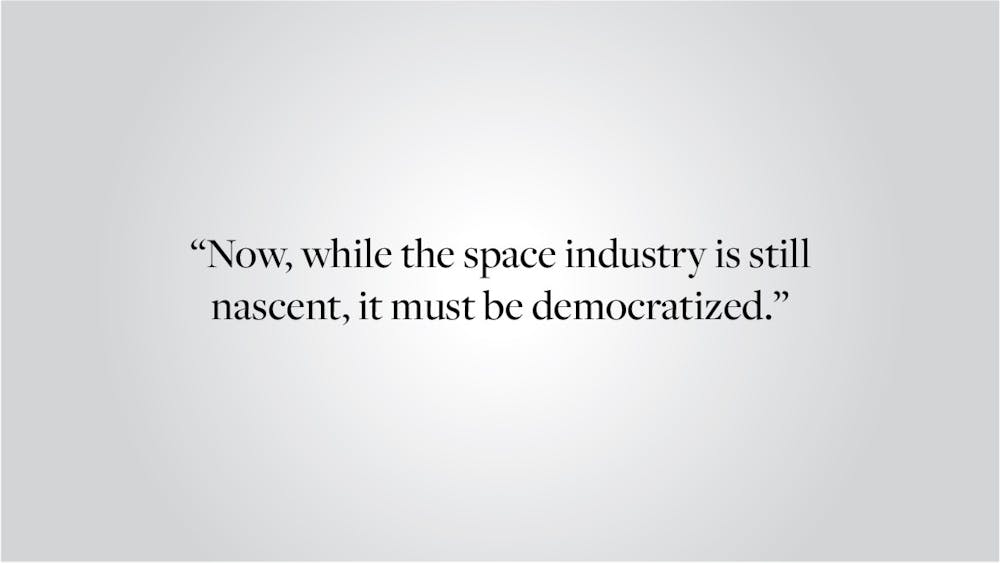Outer space has long been an object of scientific curiosity and yearning imaginations, but today, its importance in society is growing at escape velocity, quickly becoming more politically and economically critical. When space becomes practically accessible for all, it will change human civilization to an extent perhaps only matched by the harnessing of fire and the invention of the steam engine: It will herald a massive scientific revolution, introducing access to critical resources on a vast scale. Unfortunately, this coming revolution in the space industry is destined to create serious winners and losers, perhaps marginalizing countries for centuries. Now, while the space industry is still nascent, it must be democratized. Fortunately, a technology exists which is perfectly poised to enable this democratization of space — the space elevator. Its development and proper management can ensure equal access to space for all.
In 2019, the space industry generated $366 billion in revenue, a figure which is expected to increase to more than a trillion dollars by 2040. In recent years, this industry has been overwhelmingly dominated by states with the largest economies, with other countries lacking the financial and institutional resources to invest in space technology. This reality creates problems not only for disadvantaged public space programs, but also for prospective entrepreneurs in poorer countries who cannot count their governments as potential clients, unlike in the United States.
The growth of private corporations in the space industry is a new phenomenon, and its current trajectory leaves little room for democratizing space. Currently, the cheapest method of accessing space is SpaceX’s Falcon 9 rocket, which costs roughly $1,200 per pound of payload. While this price has been heralded by some as an enormous breakthrough, it is still prohibitively high for many. With countries relying on private companies for their space infrastructure quickly becoming the new norm, the price of a private launch determines which countries can leave the atmosphere. The price of cheaper space travel will make it possible for some small countries to afford to enter the space market, but will not ultimately allow less financially able states a role in what is poised to be a trillion dollar industry. For companies or countries hoping to establish more significant, economical presences in space, such as what SpaceX has done with its Starlink constellation of satellites, the costs of entry quickly become astronomical. SpaceX was able to launch over 1,300 Starlink satellites because of the company’s pre-existing launch capabilities, and the project has been estimated to require $10 billion in investment. Those groups with significant headstarts and plenty of capital have an enormous advantage, further locking out smaller actors.
This capitalizing trend will be disastrous if outer space becomes controlled similarly to resources on Earth. Consider as an analogue the current supply of rare earth metals. Over 80% of the world’s supply of these metals, critical to modern technologies, are controlled by China, giving the country enormous leverage to decide how they are distributed. As recently as 2010, China used this leverage and restricted exports. Restricting supply of these metals can cause prices on technological products to dramatically increase and put them out of reach for many. Concentrated control of space could have the same effect, allowing individual countries or corporations to command utilities like the internet. As it becomes increasingly likely that constellations of satellites will provide the internet connections of the future, the lack of a democratic process for ensuring equal space access could cripple economies and countries by putting too much power in the hands of bad actors.
The most important way space can be democratized is by making it cheap enough for any nation or group with limited resources to establish a legitimate presence in orbit, and a space elevator is a technology capable of reducing prices to such a point. At its most basic, this technology is exactly what it sounds like — a 144,000 kilometer-long elevator, connecting Earth at one end to a space station at the other and delivering payloads into space without the need for rockets. While this idea may sound like science fiction, the technology to build such a structure has all been developed, so doing so is not only technologically feasible, but also practical.
The benefits of building a space elevator would be numerous, one being the dramatic reduction in costs for sending a payload to space. Current estimates project that a space elevator would drastically reduce the cost of sending a pound of payload compared to the current cheapest options. This solution would mean that constructing a true presence in space would no longer be limited to rich nations, allowing for much smaller investments to make real economic impacts.
Society is on the brink of one of the most important technological sea changes in millenia, but it is imperative this advancement is managed responsibly. If space is not opened to all, the resultant power imbalances will be severe and difficult to ever correct. Thus, we should invest in constructing a space elevator to democratize space and, in the process, revolutionize society.
Gabe Sender ’25 can be reached at gabriel_sender@brown.edu. Please send responses to this opinion to letters@browndailyherald.com and other op-eds to opinions@browndailyherald.com.
Gabe Sender is a Staff Columnist at The Brown Daily Herald with a particular focus on campus issues and development challenges in Providence. He is currently pursuing an independent concentration in urban environmentality.





